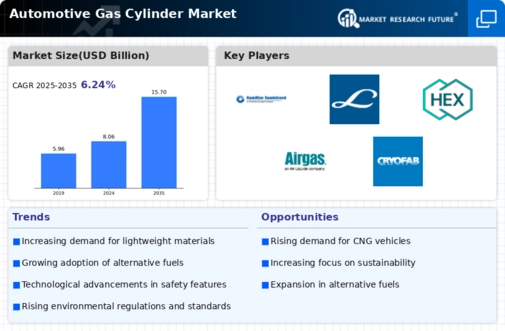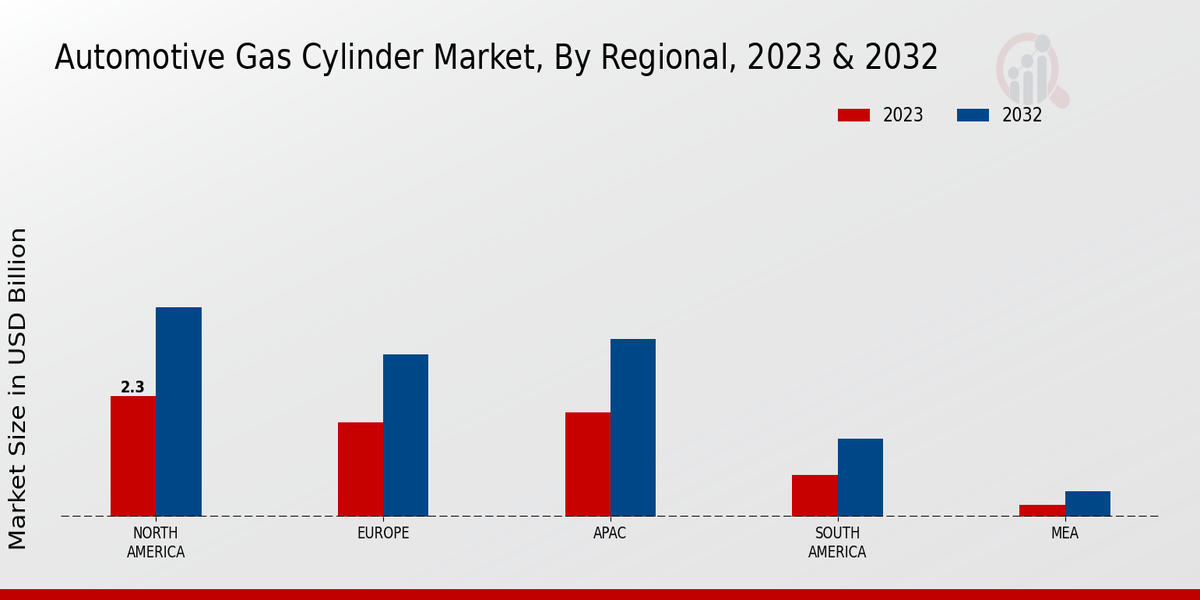Market Growth Projections
The Global Automotive Gas Cylinder Market Industry is projected to experience robust growth over the next decade. With an anticipated market value of 8.06 USD Billion in 2024, the industry is expected to expand significantly, reaching 15.7 USD Billion by 2035. This growth trajectory indicates a compound annual growth rate of 6.24% from 2025 to 2035, driven by factors such as increasing demand for lightweight materials, the adoption of alternative fuels, and advancements in manufacturing technologies. These projections highlight the industry's potential and the opportunities available for stakeholders.
Stringent Safety Regulations
The Global Automotive Gas Cylinder Market Industry is heavily influenced by stringent safety regulations imposed by governments and international organizations. These regulations mandate rigorous testing and certification processes for gas cylinders, ensuring their reliability and safety in automotive applications. Compliance with these regulations is crucial for manufacturers, as failure to meet safety standards can result in significant penalties and reputational damage. Consequently, the emphasis on safety drives innovation in design and materials, fostering a competitive landscape that prioritizes the development of safer, more efficient gas cylinders.
Rising Demand for Lightweight Materials
The Global Automotive Gas Cylinder Market Industry experiences a growing demand for lightweight materials, which enhances fuel efficiency and reduces emissions in vehicles. Manufacturers are increasingly adopting advanced composite materials for gas cylinders, which not only meet safety standards but also contribute to overall vehicle performance. This trend aligns with global sustainability goals, as lighter vehicles consume less fuel. As a result, the market is projected to reach 8.06 USD Billion in 2024, reflecting the industry's shift towards innovative materials that support environmental initiatives.
Increasing Adoption of Alternative Fuels
The Global Automotive Gas Cylinder Market Industry is witnessing a notable increase in the adoption of alternative fuels, such as compressed natural gas (CNG) and hydrogen. Governments worldwide are promoting cleaner fuel options to reduce greenhouse gas emissions and dependence on fossil fuels. This shift is evident in various regions, where incentives and subsidies are provided for vehicles utilizing these fuels. As the market evolves, the demand for specialized gas cylinders designed for these alternative fuels is expected to surge, contributing to the projected growth of the market to 15.7 USD Billion by 2035.
Growing Automotive Industry in Emerging Markets
The Global Automotive Gas Cylinder Market Industry is benefiting from the rapid growth of the automotive sector in emerging markets. Countries such as India and Brazil are experiencing increased vehicle production and sales, driven by rising disposable incomes and urbanization. This trend creates a substantial demand for automotive gas cylinders, particularly for vehicles utilizing alternative fuels. As these markets expand, manufacturers are likely to focus on establishing local production facilities to cater to the increasing demand, thereby enhancing their market presence and contributing to the overall growth of the industry.
Technological Advancements in Cylinder Manufacturing
Technological advancements in cylinder manufacturing processes are significantly influencing the Global Automotive Gas Cylinder Market Industry. Innovations such as automated production lines and advanced welding techniques enhance the efficiency and safety of gas cylinder production. These improvements not only reduce manufacturing costs but also ensure compliance with stringent safety regulations. As manufacturers adopt these technologies, the market is likely to benefit from increased production capacity and improved product quality, which may lead to a compound annual growth rate of 6.24% from 2025 to 2035.

















Leave a Comment